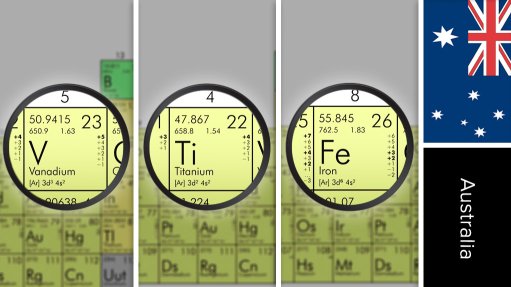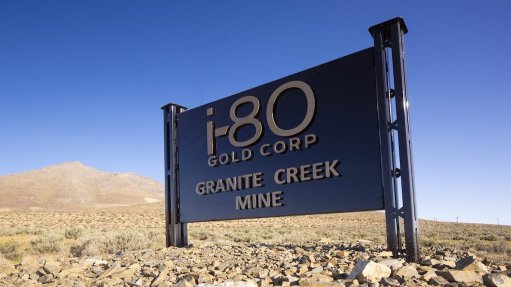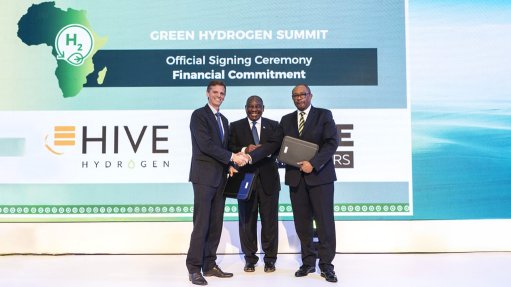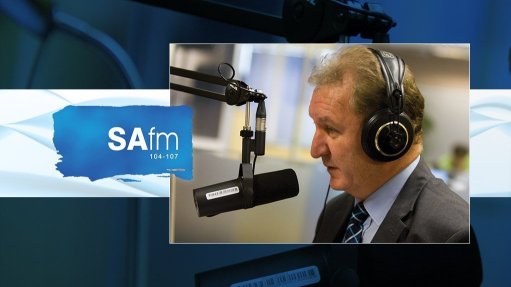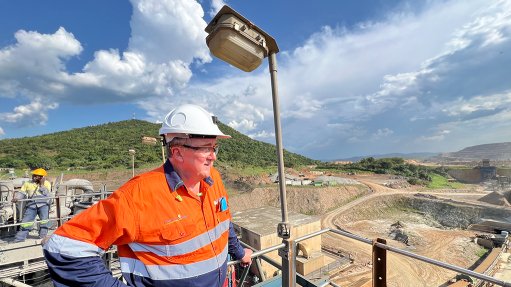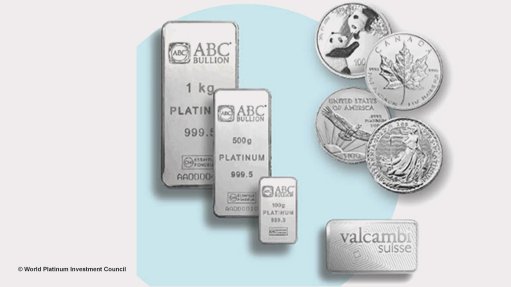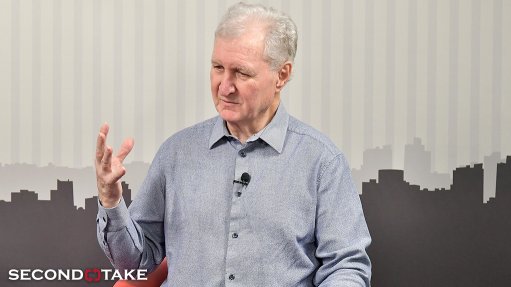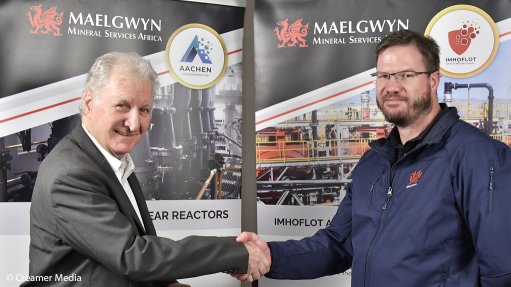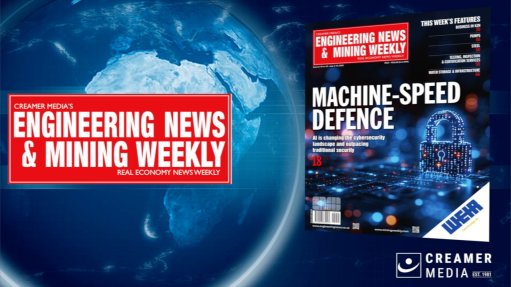Glencore pleased with its performance against the backdrop of lower commodity, energy prices

Glencore executives unpack the company's 2023 performance and production guidance
Global mining company Glencore has recommended a $0.13 a share, or $1.6-billion, base cash distribution to shareholders for the 2023 financial year, comprising $1-billion from marketing cash flows and the balance from industrial attributable cash flows.
This is despite a 50% year-on-year decrease in the group’s adjusted earnings before interest, taxes, depreciation and amortisation (Ebitda) to $17.1-billion.
Earnings per share (EPS) were also lower at to $0.34, marking a 74% decrease on the prior year’s EPS of $1.33.
CEO Gary Nagle says 2023 saw the rebalancing and normalisation of international energy trade flows, resulting in lower, albeit healthy, earnings generation in the group’s marketing and industrial segments.
Glencore generated $15.1-billion in cash from operating activities and reported a net income attributable to equity holders of $4.3-billion, despite the slower trade flows.
Nagle highlights that the distribution for the year, as well as the overall shareholder return journey, must be contextualised by the binding agreement Glencore entered into with Teck Resources last year to acquire a 77% effective interest in its steelmaking coal business, Elk Valley Resources, for $6.93-billion in cash.
He expects these world-class assets to meaningfully complement Glencore’s existing thermal and steelmaking coal production in Australia, Colombia and South Africa.
The acquisition also supports the global energy transition as an input into steel production needed for certain renewable energy infrastructure.
The transaction is expected to close in the third quarter of this year. Glencore then plans to demerge its coal and carbon steel materials business, once the group has sufficiently delivered towards a revised $5-billion net debt cap. This is expected within two years of the transaction closing.
Meanwhile, the group says it continues to maintain significant financial headroom and strength, with year-end net debt outturn contained to $4.9-billion and a net debt to adjusted Ebitda ratio of 0.29 times.
Nagle says Glencore’s capital structure and credit profile has been managed at a $10-billion net debt cap, with sustainable deleveraging below the cap being returned to shareholders through special distributions and buybacks.
The group has available liquidity of just under $13-billion.
Meanwhile, Glencore spent $5.6-billion on capital expenditure in the year under review, including by acquiring a 30% stake in Alunorte and a 45% stake in Mineracao Rio do Norte – which secures low-carbon and low-cost alumina units for the marketing business.
In copper, Glencore acquired the remaining 56% interest in the Mara brownfield copper project, in Argentina, that it did not already own, as well as the balance of Polymet shares.
Polymet operates the New Range copper/nickel venture in Minnesota, in the US, alongside Teck Resources in a 50:50 joint venture.
The copper deals resulted in more than five-billion tonnes of resource being added to Glencore’s copper resource inventory in the year under review.
The group remains focused on supporting the energy needs of the global market, while investing in its transition commodities portfolio.
SEGMENT PERFORMANCE
Glencore’s industrial segment reported a 52% lower adjusted Ebitda at $13.2-billion in the year under review, compared with the prior year, owing to lower coal earnings and lower energy prices in the reporting year.
In particular, earnings from metals were down by 41% year-on-year to $5.4-billion, reflecting lower realised cobalt, nickel and zinc prices.
In turn, lower coal prices resulted in 55% lower energy earnings at $8.5-billion.
The marketing segment’s adjusted earnings before interest and taxes (Ebit) were down 46% year-on-year at $3.5-billion, with energy Ebit amounting to $1.7-billion in a return to a more stable market environment following extreme market volatility levels in 2022.
Metals’ adjusted Ebit of $1.7-billion was 5% higher year-on-year, which Glencore says reflects consistent physical marketing conditions for many commodities.
Nagle points out that most key commodity prices trended lower in the year under review, with high interest rates impacting on consumer and industrial demand.
Increasing demand in China, supported by various infrastructure investments, offset some of the softer demand in developed markets – which kept key commodity price levels well above prior cycle lows.
Ebitda from the Viterra business was consistent with the prior year at $2.1-billion, while Glencore’s equity accounted share of Viterra declined to $321-million in the year under review.
During 2023, Glencore concluded an agreement to merge its 50% stake in Viterra with Bunge in a cash and stock transaction to create a premier diversified global agribusiness solutions company.
Glencore will receive $1-billion in cash and $3.1-billion in Bunge stock to this effect. The merger is expected to close by the middle of this year.
CLIMATE MATTERS
After extensively consulting shareholders in the reporting year, Glencore has committed to publish an updated Climate Action Transition Plan in March.
The company says there is broad support for its climate strategy, as the company aims to achieve net-zero emissions by 2050 and remain resilient to the risks and opportunities of the evolving energy transition globally.
Some principal areas of interest raised by shareholders included a comparison of Glencore’s targets and ambitions to various International Energy Agency scenarios, as well as the need for more detail on the progress made by the group on industrial emissions reductions in the short term (by 2026) and the medium term (by 2035).
OUTLOOK
Although the current macroeconomic environment remains challenging, global economic growth is forecast to bottom out this year. Expected interest rate cuts and corresponding restocking along the supply chain are likely to bring an improvement in demand conditions in Western markets later in the year, Nagle states.
He adds that supply constraints and energy transition demand prevented large inventory increases in most commodities during this cyclical trough, leaving markets well-positioned for a strong recovery as demand conditions improve.
This is particularly the case for copper, where the closure of a major mine and various cuts to production guidance through the second half of 2023 have highlighted the persistent supply challenges facing the industry.
Nagle points out these are likely to keep the market tight throughout 2024 against previous expectations of oversupply.
Foreign exchange trading platform Admirals market analyst Roberto Rivero says general mining sentiment has been negative in 2024 so far, owing to a slowing global economy and a resurgent US dollar. When the US dollar is strong, dollar-denominated commodities become relatively more expensive for non-dollar holding companies, which can lead to lower demand.
Rivero adds that there is an element of uncertainty surrounding Glencore's future, hence why its shares have performed worse than other top mining companies this year. He does not believe Glencore's financial situation looks particularly encouraging for a company that is on the brink of reinventing itself.
However, Glencore says its diversified business model across industrial and marketing, focusing on metals and energy, has proved itself adept in a range of market conditions, giving it a solid foundation to successfully navigate the near-term macroeconomic uncertainty, as well as meet the resource needs of the future.
Comments
Press Office
Announcements
What's On
Subscribe to improve your user experience...
Option 1 (equivalent of R125 a month):
Receive a weekly copy of Creamer Media's Engineering News & Mining Weekly magazine
(print copy for those in South Africa and e-magazine for those outside of South Africa)
Receive daily email newsletters
Access to full search results
Access archive of magazine back copies
Access to Projects in Progress
Access to ONE Research Report of your choice in PDF format
Option 2 (equivalent of R375 a month):
All benefits from Option 1
PLUS
Access to Creamer Media's Research Channel Africa for ALL Research Reports, in PDF format, on various industrial and mining sectors
including Electricity; Water; Energy Transition; Hydrogen; Roads, Rail and Ports; Coal; Gold; Platinum; Battery Metals; etc.
Already a subscriber?
Forgotten your password?
Receive weekly copy of Creamer Media's Engineering News & Mining Weekly magazine (print copy for those in South Africa and e-magazine for those outside of South Africa)
➕
Recieve daily email newsletters
➕
Access to full search results
➕
Access archive of magazine back copies
➕
Access to Projects in Progress
➕
Access to ONE Research Report of your choice in PDF format
RESEARCH CHANNEL AFRICA
R4500 (equivalent of R375 a month)
SUBSCRIBEAll benefits from Option 1
➕
Access to Creamer Media's Research Channel Africa for ALL Research Reports on various industrial and mining sectors, in PDF format, including on:
Electricity
➕
Water
➕
Energy Transition
➕
Hydrogen
➕
Roads, Rail and Ports
➕
Coal
➕
Gold
➕
Platinum
➕
Battery Metals
➕
etc.
Receive all benefits from Option 1 or Option 2 delivered to numerous people at your company
➕
Multiple User names and Passwords for simultaneous log-ins
➕
Intranet integration access to all in your organisation







